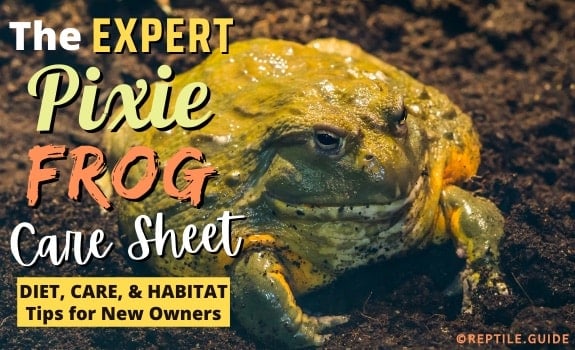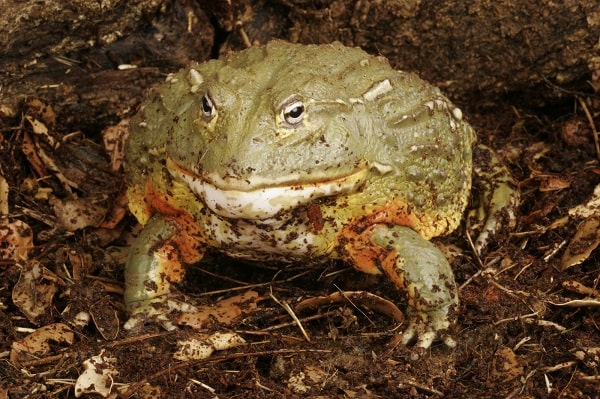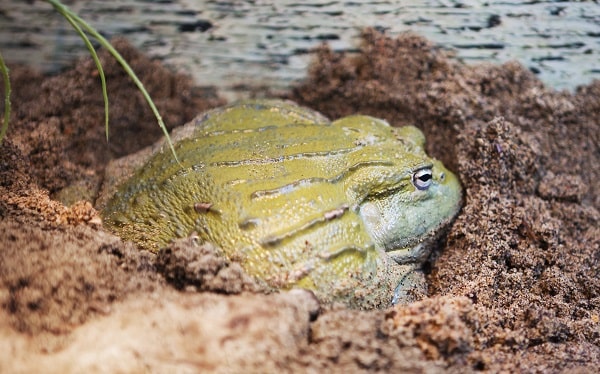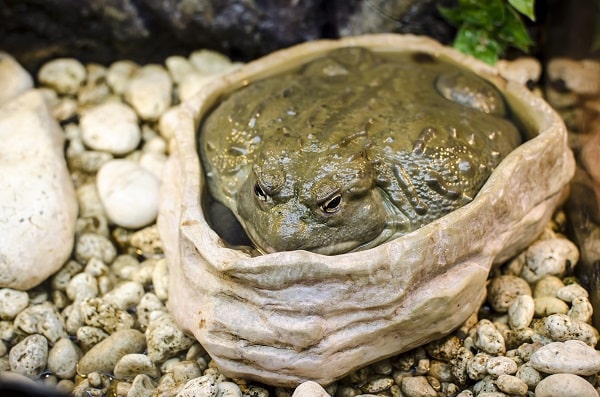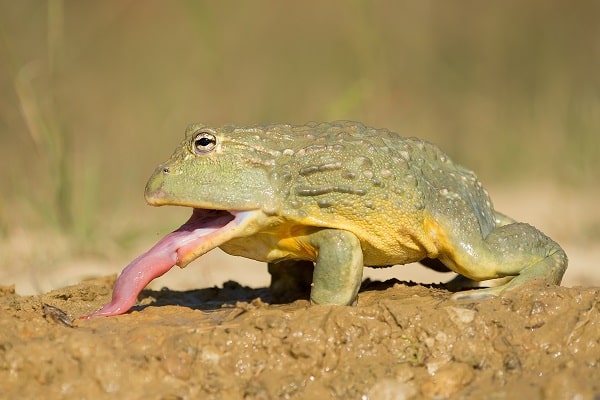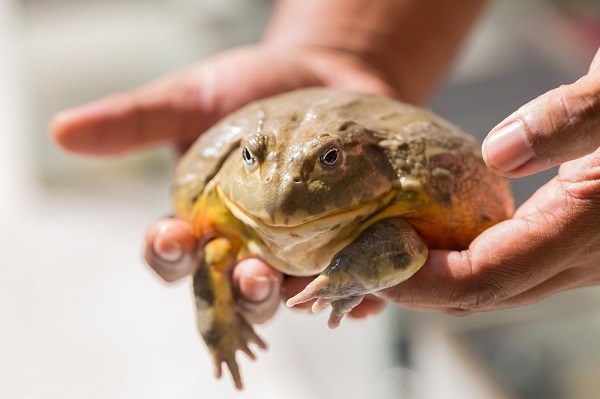With a name like Pixie Frog, you’re probably expecting something small, cute, maybe with pastel colors and intricate patterns.
Prepare to have your expectations thrown out the window.
Pixie Frogs are giant, chubby, boisterous, meaty, ravenous, toad-like frogs. There’s nothing fairy-like about them, except for the fact that they’d probably eat pixies if they existed.
If this sounds like the type of vibe you want to nurture in your home, rock on! Keep reading to learn how to care for these big ol’ blobs of personality and spunk.
In This Article
Pixie Frog Species Summary
Pixie Frogs (Pyxicephalus adspersus), also commonly known as African Bullfrogs, are a huge species of frog native to the savannahs, shrublands, and water bodies of southern Africa.
Pixie Frogs are named after their Latin name, which is why you’ll sometimes see it spelled as ‘Pyxie Frog’, too.
In their natural habitat, they experience both arid and wet conditions, depending on the season.
During the dry season, Pixie Frogs enter a dormancy period where they grow several additional skin layers to act as a ‘cocoon’ to retain moisture in their body. This biological process is referred to as estivation.
Pixie Frogs are voracious and indiscriminate carnivores, happily eating anything that moves and will fit into their large mouths.
Their natural diet includes, but is not limited to:
- Insects
- Small mammals
- Reptiles
- Birds
- Other amphibians
Pixie Frogs breed during the wet season in their native range.
Mating behavior is triggered by heavy rainfall, which causes males to congregate in shallow, temporary water bodies.
One large, dominant male will position himself in the center of the pool and guard it from smaller males, who will be stuck on the outskirts.
Males emit a one-second-long, low-pitched ‘whoop,’ which attracts nearby females.
When the females reach the pool, they dive underwater, avoiding the smaller, subordinate males, and swim to the center so that the strongest male can fertilize their eggs.
Pixie Frogs engage in a common amphibian mating position known as amplexus.
The male hugs the female’s waist, which triggers the female to release her eggs, and the male fertilizes them externally by simultaneously releasing his sperm.
Around 30,000 to 40,000 eggs are laid, and they hatch within 3 days.
Tadpoles feed on plant and animal matter and take about 30 days to morph into little Pixie Froglets.
Interestingly, the dominant male will protect the tadpoles until they’re ready to leave the water, but he also occasionally eats some of them while standing guard.
| Facts at a Glance: | |
|---|---|
| Common name | Pixie Frog & African Bullfrog |
| Scientific name | Pyxicephalus adspersus |
| Adult size | Males: 5.5-10 inches, Females: 3.5-5.5 inches |
| Price | $25 to $75 |
| Lifespan | 35 years |
| Diet | Carnivores |
| Tank Size | 20-40 gallon tank depending on gender |
| Temperature & Humidity | 75-85°F Degrees Fahrenheit & 60-80% Humidity |
| Popular alternatives | Pacman Frog, Tomato Frog |
Appearance & Colors
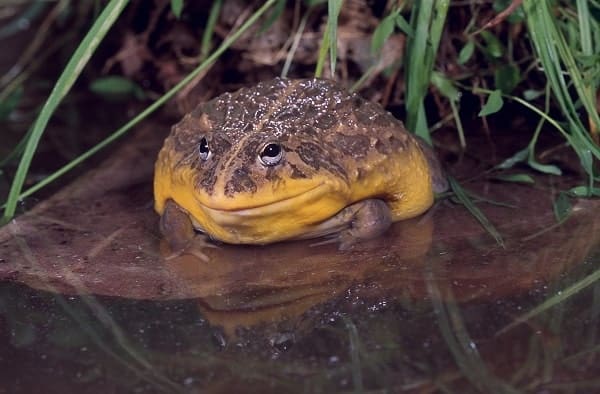
Pixie Frogs are large and chubby with comparatively short, thin legs.
At times, their little nubs are entirely hidden by their fat body tissue!
They are arguably even chubbier than the ‘Chubby Frog‘ – the Asian Painted Frog even named after its body shape.
They have irregular, broken-line ridges of bumps running from the back of their head to their rump. Their mouths are large and full of small teeth. Their eyes protrude above the top of their heads.
The top of their body ranges from bright lime to dark olive green, and they have yellow or orange bellies and arms.
Pixie Frog Size
Pixie Frogs are the second-largest frog species in the world, after the Goliath Frog (Conraua goliath).
Unlike most amphibian species, male Pixie Frogs are significantly larger than their female counterparts.
Usually, the female amphibian is larger to facilitate an easier amplexus position.
Male Pixie frogs grow to be between 5.5 and 10 inches long, weighing up to 2 pounds. In contrast, female Pixie Frogs grow to around half that size, topping out at 3.5 to 5.5 inches and less than 1 pound.
Lifespan
Pixie Frogs have surprisingly long lifespans, and it’s not unheard of for captive animals to live for 35 years.
Wild Pixie Frogs may have even longer lifespans, thanks to their dormancy periods, which have proven to extend many organisms’ total lifespan.
The average lifespan of a captive Pixie Frog that experiences no dry-season dormancy or estivation is thought to be 20 to 30 years.
Pixie Frog Care Sheet
Basic Requirements at a Glance:
- 20-Gallon (female) or 40-Gallon (male) Aquarium
- Screen Lid
- Coconut Fiber
- Water Dish
- Heating Element
- Thermostat
Enclosure Size & Dimensions
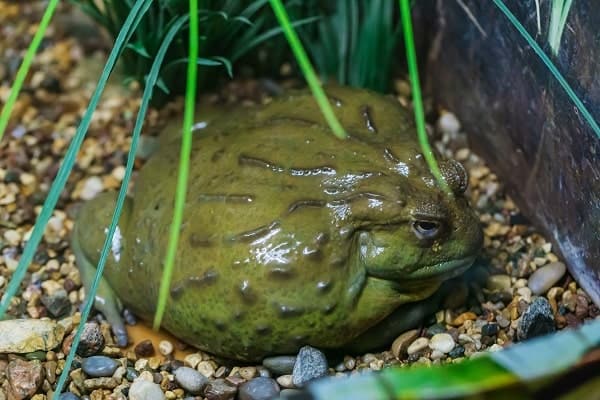
| Minimum Adult Male Floor Space: | 4 sq. ft. (40-gallon aquarium or equivalent) |
| Minimum Adult Female Floor Space: | 2.5 sq. ft. (20-gallon long aquarium or equivalent) |
Pixie Frogs are BIG, and while they aren’t particularly active, they do need space to move, exercise, explore, and thermoregulate.
Since males are so much larger than females, they require a larger-sized enclosure.
A common misconception is that Pixie Frogs stay buried and don’t move around very much.
On the contrary, keepers that provide their Pixie Frog with more space have observed that they enjoy coming out every night to move around and, especially, swim!
That’s why we’ve suggested a larger enclosure than is commonly accepted for this species.
Of course, young babies can be started in smaller 5- or 10-gallon aquariums.
Tubs with similar dimensions may also be used for young animals and adults. They offer additional benefits, such as helping your animal feel secure and maintaining high humidity levels.
Habitat Setup
The core aspects of a Pixie Frog habitat are deep, loose substrate for burrowing and a large, deep dish for swimming.
Most Pixie Frog keepers have the most luck with the following substrates:
- Coconut fiber
- Sphagnum moss
- DIY tropical soil mixture
These substrates are easy for your frog to excavate, and they do an excellent job of holding onto moisture to raise the enclosure’s humidity.
Keep the substrate at a depth of 4-6″ so your Pixie Frog can bury himself completely.
Many Pixie Frog owners aren’t aware that their pet can, in fact, swim… and enjoys swimming! Their water feature can occupy as much as 40% of their enclosure’s total floor space, and they will utilize every inch.
Be sure to add substrate, rocks, bricks, or other amphibian-safe materials to any deep water bodies so that your Pixie Frog can climb out and have shallow areas to soak in.
Other optional habitat additions include:
- A filter for the water feature
- Live plants, cork bark
- Branches
- Rocks
- Suitably-sized hides
These items will give your Pixie Frog different textures and heights to explore, enriching his life – which is what we should all aim to do as owners and caretakers (of any pet frog species for that matter)!
Temperature & Lighting
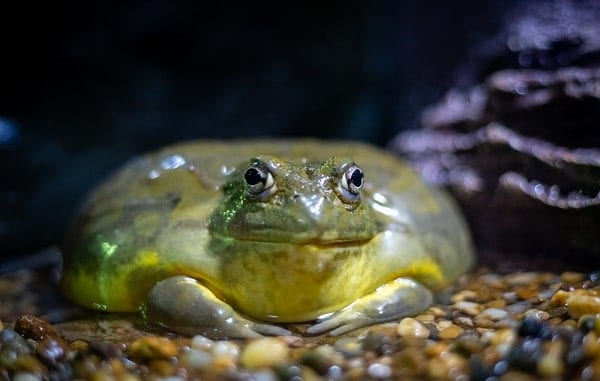
Ideal Temperature Gradient: 75-85°F
Pixie Frogs need a warm side in the mid to upper 80s, with the cool side being slightly higher than room temperature. The ambient temperature in the enclosure can fall to room temperature, 70-72°F, at night.
For a heat source, you can use any of the following inside your African Bullfrogs enclosure:
- Heating pad
- Heat tape
- Heat cable
- Ceramic heat emitter
- Carbon filament heat projector
- Incandescent lightbulb
Avoid using colored ‘night heat lights’ at night because your Pixie Frog can still see those lights, and they will disrupt your frog’s day and night cycle.
If you use an incandescent lightbulb for heat during the day, be sure to turn it off for at least 10 hours every night.
Nighttime is when your Pixie Frog will be most active, and visible light should be kept to a minimum.
If you don’t use an incandescent heat light during the day, be sure that your Pixie Frog has some other light source, whether it’s LED lighting, overhead room lighting, or sunlight from the windows.
Reptiles and amphibians need some source of light to differentiate daytime from nighttime.
UVB lighting may also be beneficial for your frog because it aids in Vitamin D3 synthesis and calcium absorption.
There have been cases of Pixie Frogs and other amphibians developing MBD from a lack of UVB, so it’s worth considering if your budget and set-up allow for it.
UVB light bulbs typically need to be situated 10-12” away from the animal at all times. Nocturnal animals, like Pixie Frogs, require low-output UVB bulbs.
Never leave the UVB light on for more than 12 hours per day.
Humidity
Ideal Humidity: 60-80%
Because they are amphibians, Pixie Frogs require high humidity.
Fortunately, Pixie Frogs have evolved to survive periods of drought, so allowing the habitat to dry out won’t kill them. It can, however, cause them to go into estivation.
They will dig a burrow, grow several layers of cocoon-like skin, and stay there for several weeks until they experience significant levels of moisture and humidity.
Many overhead heating options will reduce the enclosure’s humidity faster, but this isn’t necessarily a bad thing.
Although you will have to mist the enclosure and add water to the substrate more often, this constant cycle helps prevent bacterial and fungal growth.
A large water feature with an air stone or sponge filter, live plants, and suitable substrate will do wonders at maintaining such a high level of humidity in your Pixie Frog’s habitat.
Water
Water is a vital component of life for any living organism, but amphibians, especially, need water to survive.
They lose and absorb water rapidly through their permeable skin.
The risks this presents in captivity are two-fold: Pixie Frogs can quickly become dehydrated, and they are sensitive to any chemicals found in the water.
Most amphibian keepers wisely use an aquarium water conditioner to remove chlorine and other harsh chemicals from tap water before adding it to their Pixie Frog’s enclosure.
It may also be beneficial to install a turtle filter or sponge filter to the water feature because amphibians continuously excrete small amounts of ammonia from their skin.
If you don’t use a filter in your frog’s water, you must change it and clean the container daily.
Food & Diet
Pixie Frogs in captivity can eat any of the following:
- Insects
- Worms
- Mollusks
- Cooked meat
- Organs
- Feeder fish
- Feeder rodents
Worms are fun and exciting prey for Pixie Frogs, and they typically have perfect calcium: phosphorus ratio.
Many keepers advise that red wigglers and nightcrawlers be used as the base of a Pixie Frog’s diet.
Be sure to buy organically raised worms from compost bins or feeder worm producers because worms reared for bait are frequently exposed to unknown and harmful chemicals.
Compost worms can even be ‘gut-loaded’ with calcium-rich fresh fruits and vegetables.
Other commercially-produced feeder insects will do as a staple diet, as long as they are occasionally gut-loaded or coated with calcium powder.
Pixie Frog Diet & Feeding Guidelines:
- Large crickets, roaches, and super worms are especially filling for huge, gluttonous males.
- Black soldier fly larvae are high in calcium and don’t need to be dusted, but they are relatively small.
- Rodents are high in fat and difficult to digest, so they should only be fed as a treat once or twice per month.
- Feeder fish and ghost shrimp make excellent high-calcium vertebrate additions to your Pixie Frog’s diet. Limit these items to once per week.
- Cooked meat and organs are fine as occasional treats.
Pixie Frogs hunt by sight, so they prefer live, moving prey.
However, they have such a large appetite that they can usually be tempted to accept frozen-thawed, canned, or freeze-dried prey from a pair of tongs.
Dust any prey item with a reptile multivitamin once per week. Read on here to learn more about what frogs, in general, should and should not eat.
When feeding, remember that Pixie Frogs are capable of delivering a nasty bite thanks to the sharp, fang-like projections on their lower jaw. If you find this fascinating, our frog teeth article can tell you more!
Potential Health Issues
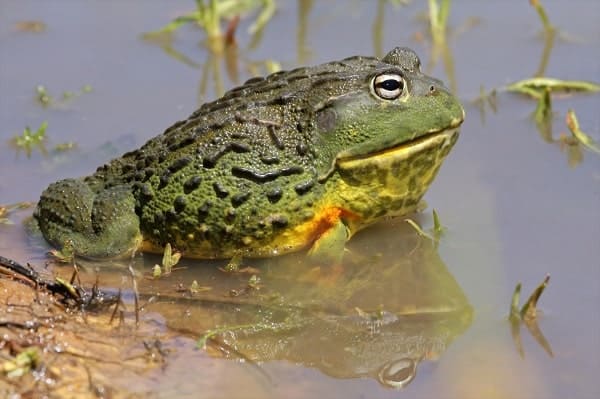
The most common health issue in Pixie Frogs, by far, is obesity.
In fact, Pixie Frogs will not stop eating on their own accord. If you put food in front of them, they will gulp it down!
Adult Pixie Frogs only need to eat two or three decent meals per week, or you may choose to feed them smaller meals every day with at least one fasting day per week.
Fungal infections are common in most amphibians, and they usually stem from poor cage cleanliness and low airflow.
Ensure your Pixie Frog’s habitat is well-ventilated, spot clean waste as needed, and completely change the substrate every 1 to 3 months to prevent infections.
IBD is another common issue in captive amphibians and stems from lack of UVB lighting and improper dietary calcium: phosphorus ratio.
If you’re using commercially produced feeder insects, be sure to gut-load them or dust them with calcium every 2nd or 3rd meal.
If that still isn’t working, find a way to provide your Pixie Frog with UVB lighting.
Behavior & Temperament
Pixie Frogs are known for their nasty temperament and willingness to bite.
Luckily, Pixie Frog bites are easily avoided and aren’t terribly painful.
In fact, their defense tactics are often more comical than scary.
If you’re lucky, they’ll let you know that they’re getting upset by puffing up their body and making a loud croaking or bleating sound before they bite you, instead of afterward. Don’t count on it, though!
Pixie Frog Handling
Amphibians, in general, shouldn’t be frequently handled due to their permeable skin.
Human skin dries them out and can introduce harmful chemicals and minerals.
If you decide to handle your Pixie Frog or need to move it, use a gentle but firm grip.
Their large size and shockingly strong legs make them awkward to hold, so they’re prone to significant injuries from being dropped.
Most Pixie Frogs will be happy to accept food from a pair of tongs, which is an excellent bonding and interaction activity.
Do Pixie Frogs Make Good Pets? A Summary
While they certainly don’t stand up to their cutesy name, Pixie Frogs make excellent, entertaining, hardy pets that are full of personality.
They’re relatively simple to care for but create the perfect challenge for keepers who have experience with solely aquatic or terrestrial animals.
We hope we’ve helped you to adequately prepare yourself for the big, boisterous African Bullfrog.
If you are interested in another frog instead, check out the White’s tree frog – one of the easiest to care for species!
